A Preliminary Studies of the Impact of a Conveyor Belt on the Noise Emission
Abstract
1. Introduction
2. Materials and Methods
2.1. Background Acoustics, Reference Standards and Methodology
- ΔLeq—difference in sound pressure level when the machinery is switched on or off.
- Leq—measured sound pressure level.
2.2. Measuring Apparatus
3. Results
4. Discussion
4.1. Belt Noise Depending on the Tensile Force
4.2. Belt Noise Depending on Speed
5. Conclusions
Author Contributions
Funding
Institutional Review Board Statement
Informed Consent Statement
Data Availability Statement
Acknowledgments
Conflicts of Interest
References
- Alspaugh, M. Bulk Material Handling by Conveyor Belt 7; Society for Mining, Metallurgy, and Exploration: Englewood, CO, USA, 2008; ISBN 0873352602. [Google Scholar]
- Middelberg, A.; Zhang, J.; Xia, X. An optimal control model for load shifting—With application in the energy management of a colliery. Appl. Energy 2009, 86, 1266–1273. [Google Scholar] [CrossRef]
- Pihnastyi, O.; Kozhevnikov, G.; Glavchev, M. Energy Management Strategy in the Synthesis of an Algorithm for Multi-step Conveyor Belt Speed Control. In Proceedings of the Grabchenko’s International Conference on Advanced Manufacturing Processes, Odessa, Ukraine, 7–10 September 2021; pp. 33–42. [Google Scholar] [CrossRef]
- Lauhoff, H. Speed control on belt conveyors—Does it really save energy? Bulk Solids Handl. 2005, 25, 368–377. [Google Scholar]
- Kawalec, W.; Kulinowski, P. Obliczenia przenośników taśmowych metodą podstawową oraz oporów jednostkowych w zintegrowanym środowisku programowym. Transport Przemysłowy 2007, 1, 6–11, (In Polish, no English translation). [Google Scholar]
- Zhang, S.; Tang, Y. Optimal control of operation efficiency of belt conveyor. In Proceedings of the 2011 Asia-Pacific Power and Energy Engineering Conference APPEEC, Wuhan, China, 25–28 March 2011. [Google Scholar] [CrossRef]
- Liu, J.; Wang, B.; Lu, S. Research and Design on Long-Distance Large-Capacity and High-Speed Belt Conveyor. Adv. Mater. Res. 2012, 538–541, 3070–3073. [Google Scholar] [CrossRef]
- Dilefeld, M. Long Distances, High Performance: Gearless Drives for High Capacity Belt Conveyors. 2014, 55, 75–80. Available online: https://www.researchgate.net/publication/291212902_Long_distances_high_performance_Gearless_drives_for_high_capacity_belt_conveyors (accessed on 18 February 2022).
- Gładysiewicz, L.; Król, R.; Kisielewski, W.; Kaszuba, D. Experimental determination of belt conveyors artificial friction coefficient. Acta Montan. Slovaca 2017, 22, 206–214. [Google Scholar]
- Bajda, M.; Hardygóra, M. Analysis of the Influence of the Type of Belt on the Energy Consumption of Transport Processes in a Belt Conveyor. Energies 2021, 14, 6180. [Google Scholar] [CrossRef]
- Król, R.; Gladysiewicz, L.; Kaszuba, D.; Kisielewski, W. New Quality Standards of Testing Idlers for Highly Effective Belt Conveyors. IOP Conf. Ser. Earth Environ. Sci. 2017, 95, 042055. [Google Scholar] [CrossRef]
- Directive 2006/42/EC of the European Parliament and of the Council of 17 May 2006 on Machinery; Council of Europe: Strasbourg, France, 2006.
- Directive 2000/14/EC of the European Parliament and of the Council of 8 May 2000 on the Approximation of the Laws of the Member States Relating to the Noise Emission in the Environment by Equipment for Use Outdoors; Council of Europe: Strasbourg, France, 2000.
- Regulation (EU) 2019/1243 of the European Parliament and of the Council of 20 June 2019 Adapting a Number of Legal Acts Providing for the Use of the Regulatory Procedure with Scrutiny to Articles 290 and 291 of the Treaty on the Functioning of the Europea; Council of Europe: Strasbourg, France, 2019.
- PN-EN ISO 3740 Acoustics—Determination of Sound Power Levels of Noise Sources Using Sound Intensity. Available online: https://www.iso.org/standard/24012.html (accessed on 18 February 2022).
- Act of 29 August 2003 Amending the Act on the System of Conformity Assessment and Amending of Certain Acts; Council of Europe: Strasbourg, France, 2003.
- Directive 2012/27/EU of the European Parliament and of the Council of 25 October 2012 on Energy Efficiency; Council of Europe: Strasbourg, France, 2012.
- Directive 2010/75/EU of the European Parliament and of the Council of 24 November 2010 on Industrial Emissions (Integrated Pollution Prevention and Control); Council of Europe: Strasbourg, France, 2010.
- Kaźmierczak, U.; Stopa, M. Valuation of industry noise impact in open-pit mining. Min. Sci. 2014, 21, 89–97. (In Polish) [Google Scholar]
- Chee, F.Y.; Koper, A. Poland Refuses to Halt Disputed Coal Mine Despite EU Court Penalty; Reuters: London, UK, 2021. [Google Scholar]
- Madahana, M.C.; Nyandoro, O.T.; Moroe, N.F. Engineering noise control for mines: Lessons from the world. S. Afr. J. Commun. Disord. 2020, 67, 1–5. [Google Scholar] [CrossRef] [PubMed]
- Idczak, H.; Rudno-Rudzinska, B.; Mazurek, C. Reducing noise pollution from belt conveyors in surface mines. Gornictwo Odkrywkowe 1989, 31, 54–69. [Google Scholar]
- Brown, S.C. Conveyor Noise Specification and Control. In Proceedings of the 2004 Annual Conference of the Australian Acoustical Society, Gold Coast, Australia, 3–5 November 2004; pp. 269–276. [Google Scholar]
- Klimenda, F.; Soukup, J.; Sterba, J. Noise and Vibration Analysis of Conveyor Belt. Manuf. Technol. 2019, 19, 604–608. [Google Scholar] [CrossRef]
- Liptai, P.; Lumnitzer, E.; Moravec, M.; Piňosová, M. Analysis and Classification of Noise Sources of Conveyor Systems by Sound Visualizing on the Postal Package Sorting Line. Adv. Sci. Technol. Res. J. 2018, 12, 172–176. [Google Scholar] [CrossRef]
- Bortnowski, P.; Nowak-Szpak, A.; Król, R.; Ozdoba, M. Analysis and Distribution of Conveyor Belt Noise Sources under Laboratory Conditions. Sustainability 2021, 13, 2233. [Google Scholar] [CrossRef]
- Ladányi, G. Study on the noise emission of belt conveyor idler rolls. Ann. Univ. Petrosani Mech. Eng. 2016, 18, 83–92. [Google Scholar]
- Sadowski, J.; Fąs, T.; Stosowanej, Z.M. Noise minimization of belt conveyor used for lignite coal transportation. Inżynieria i Aparatura Chemiczna 2014, 53, 113–115. (In Polish) [Google Scholar]
- Gondek, H.; Kolman, J.; Bohác, D. Noise reduction of belt conveyor tracks. In Proceedings of the International Multidisciplinary Scientific GeoConference: SGEM, Albena, Bulgaria, 16–25 August 2020; pp. 195–202. [Google Scholar] [CrossRef]
- McLoughlin, J. Environmental Noise Management Strategy for the Wagerup 3 Expansion Project; SVT Engineering Consultants: Perth, Australia, 2005. [Google Scholar]
- Liu, Y.; Miao, C.; Li, X.; Ji, J.; Meng, D. Research on the fault analysis method of belt conveyor idlers based on sound and thermal infrared image features. Measurement 2021, 186, 110177. [Google Scholar] [CrossRef]
- Bennett, S.C. Conveyor belt noise. Min. Mag. 1983, 148, 449–455. [Google Scholar]
- Chen, G.; Zhen, H.; Qatu, M. Noise Modeling of Synchronous Belts. Noise Vib. Worldw. 2013, 44, 14–27. [Google Scholar] [CrossRef]
- Yaochen, S.; Tianxiang, Z.; Guoping, C.; Zhanguo, L.; Wusheng, T. Noise source identification of three pulleys and one belt drive system based on sound array technology. Meas. Control 2020, 53, 1625–1632. [Google Scholar] [CrossRef]
- Koyama, T.; Watanabe, K.; Nagai, K.; Kagotani, M. A Study on Timing Belt Noise (How to Reduce Resonant Noise). J. Mech. Des. 1990, 112, 419–423. [Google Scholar] [CrossRef]
- Watanabe, K.; Koyama, T.; Nagai, K.; Kagotani, M. A Study on Timing Belt Noise (Theoretical Analysis for Forced Transverse Vibration of Timing Belt With Parametric Excitation). J. Mech. Des. 1990, 112, 424–429. [Google Scholar] [CrossRef]
- Koyama, T.; Kagotani, M.; Hoshiro, T. Timing belt noise. A comparison between trapezoidal tooth profile belt and circular tooth profile belt. Trans. Jpn. Soc. Mech. Eng. Ser. C 1988, 54, 2278–2283. [Google Scholar] [CrossRef][Green Version]
- Kagotani, M.; Aida, T.; Koyama, T.; Sato, S.; Hoshiro, T. Some Methods to Reduce Noise in Toothed Belt Drives. Bull. JSME 1981, 24, 723–728. [Google Scholar] [CrossRef][Green Version]
- Kubo, A.; Ando, T.; Sato, S.; Aida, T.; Hoshiro, T. On the Running Noise of Toothed Belt Drive: 2nd Report, Influence of Running Condition and Some Noise Reduction Methods. Bull. JSME 1971, 14, 998–1007. [Google Scholar] [CrossRef][Green Version]
- Kubo, A.; Ando, T.; Sato, S.; Aida, T.; Hoshiro, T. On the Running Noise of Toothed Belt Drive: 1st Report, Mechanism of Noise Generation. Bull. JSME 1971, 14, 991–997. [Google Scholar] [CrossRef]
- Leamy, M.J.; Wasfy, T.M. Analysis of Belt-Driven Mechanics Using a Creep-Rate-Dependent Friction Law. J. Appl. Mech. 2002, 69, 763–771. [Google Scholar] [CrossRef]
- Persson, B.N.J. Conveyor Belt Drive Physics. Tribol. Lett. 2020, 68, 1–9. [Google Scholar] [CrossRef]
- Kaiser, H.J.; Querengässer, J.; Bündgens, G.M. Special Noise Problems in Automotive Timing Belts; SAE Technical Paper 931316; SAE International: Warrendale, PA, USA, 1993. [Google Scholar] [CrossRef]
- Ganji, M.R.; Ghelmani, A.; Golroo, A.; Sheikhzadeh, H. A Brief Review on the Application of Sound in Pavement Monitoring and Comparison of Tire/Road Noise Processing Methods for Pavement Macrotexture Assessment. Arch. Comput. Methods Eng. 2020, 28, 2977–3000. [Google Scholar] [CrossRef]
- De Gonzalo, L.; Del Pizzo, A.; Teti, L.; Moro, A.; Bianco, F.; Fredianelli, L.; Licitra, G. Evaluation of tyre/road noise and texture interaction on rubberised and conventional pavements using CPX and profiling measurements. Road Mater. Pavement Des. 2020, 21, S91–S102. [Google Scholar] [CrossRef]
- Lee, S.K.; An, K.; Cho, H.Y.; Hwang, S.U. Prediction and Sound Quality Analysis of Tire Pattern Noise Based on System Identification by Utilizing an Optimal Adaptive Filter. Appl. Sci. 2019, 9, 3995. [Google Scholar] [CrossRef]
- Li, T. Literature review of tire-pavement interaction noise and reduction approaches. J. Vibroeng. 2018, 20, 2424–2452. [Google Scholar] [CrossRef]
- Burdzik, R. The Research on Influence of Tire Air Pressure on Noise Generatd By Vehicles Tire. Zeszyty Naukowe Politechniki Śląskiej 2013, 78, 13–18. (In Polish) [Google Scholar]
- Muthukrishnan, M. Effects of Material Properties on Tire Noise; SAE Technical Paper 900762; SAE International: Warrendale, PA, USA, 1990. [Google Scholar] [CrossRef]
- Bühlmann, E.; Egger, S.; Mioduszewski, P.; Sandberg, U. An in-depth look at the tire rubber hardness influence on tire/road noise measurements. In Proceedings of the INTER-NOISE 2018 Conference, Chicago, IL, USA, 26–29 August 2018; pp. 1–12. [Google Scholar]
- Ejsmont, J.A.; Sandberg, U.; Taryma, S. Influence of Tread Pattern on Tire/Road Noise; SAE Technical Paper 841238; SAE International: Warrendale, PA, USA, 1984. [Google Scholar] [CrossRef]
- Bortnowski, P.; Gładysiewicz, L.; Król, R.; Ozdoba, M. Models of Transverse Vibration in Conveyor Belt—Investigation and Analysis. Energies 2021, 14, 4153. [Google Scholar] [CrossRef]
- Andrianov, I.V.; van Horssen, W.T. On the transversal vibrations of a conveyor belt: Applicability of simplified models. J. Sound Vib. 2008, 313, 822–829. [Google Scholar] [CrossRef]
- Kasza, P.; Kulinowski, P.; Zarzycki, J. The Influence of an Operating Conditions on the Friction Coefficient in Transportation Machines Drives. New Trends Prod. Eng. 2020, 3, 294–302. [Google Scholar] [CrossRef]
- Fedorko, G.; Belusko, M.; Hegedus, M. FEA Utilization for Study of the Conveyor Belts Properties in the Context of Internal Logistics Systems. In Proceedings of the Carpathian Logistics Congress, Zakopane, Poland, 28–30 November 2016; pp. 293–299. [Google Scholar]
- Bobojanov, M.K.; Ziyodulla, O.E.; Ismoilov, M.T.U.; Arziev, E.I.U.; Togaeva, G.Z. Study of the efficiency of conveyors of mining transport systems of mining complexes. E3S Web Conf. 2020, 177, 03023. [Google Scholar] [CrossRef]
- Yalavarthi, V.; Kandregula, R.; Raghu Ram, K.S. Experimental Analysis of Stress, Strain and Deformation on Different Types of Conveyor Belt Pulleys. An Analysis Conducted at Visakhapatnam Steel Plant. J. Aircr. 2016, 23, 438–443. [Google Scholar] [CrossRef]
- Rezaeian, I.; Zahedi, P.; Rezaeian, A. Rubber adhesion to different substrates and its importance in industrial applications: A review. J. Adhes. Sci. Technol. 2012, 26, 721–744. [Google Scholar] [CrossRef]
- Job, L.; Joseph, R. Studies on the adhesives for rubber to rubber bonding. J. Adhes. Sci. Technol. 1995, 9, 1427–1434. [Google Scholar] [CrossRef]
- Gładysiewicz, L. Belt Conveyors: Theory and Calculations; Oficyna Wydawnicza Politechniki Wrocławskiej: Wrocław, Poland, 2003; ISBN 83-7085-737-X. (In Polish) [Google Scholar]
- Mišković, Ž.; Mitrović, R.; Maksimović, V.; Milivojević, A. Analiza i predviđanje vibracija kotrljajnih kugličnih ležaja kontaminiranih nečistoćama s površinskih kopova uglja. Tehnički Vjesnik 2017, 24, 1941–1950. [Google Scholar] [CrossRef]
- Stawecki, W.; Merkisz, J.; Bajerlein, M.; Daszkiewicz, P. New technologies of enhanced plastic for use in rail vehicles to reduce noise emissions. Combust. Engines 2017, 171, 145–149. [Google Scholar] [CrossRef]
- Fu, Y.; Kabir, I.I.; Yeoh, G.H.; Peng, Z. A review on polymer-based materials for underwater sound absorption. Polym. Test. 2021, 96, 107115. [Google Scholar] [CrossRef]
- Zhang, Y. Measuring Acoustic Attenuation of Polymer Materials Using Drop Ball Test. Master’s Thesis, Embry-Riddle Aeronautical University, Daytona Beach, FL, USA, 2013. [Google Scholar]
- Krawiec, P.; Warguła, Ł.; Czarnecka-Komorowska, D.; Janik, P.; Dziechciarz, A.; Kaczmarzyk, P. Chemical compounds released by combustion of polymer composites flat belts. Sci. Rep. 2021, 11. [Google Scholar] [CrossRef] [PubMed]
- ISO 15236-1:2016; Steel Cord Conveyor Belts—Part 1: Design, Dimensions and Mechanical Requirements for Conveyor Belts for General Use. International Organization for Standardization: Geneva, Switzerland, 2016.
- ISO 7622-2:2015; Steel Cord Conveyor Belts—Longitudinal Traction Test—Part 2: Measurement of Tensile Strength. International Organization for Standardization: Geneva, Switzerland, 2015.
- ISO 7590:2018; Steel Cord Conveyor Belts—Methods for the Determination of Total Thickness and Cover Thickness. International Organization for Standardization: Geneva, Switzerland, 2018.
- ISO 37:2005; Rubber, Vulcanized or Thermoplastic—Determination of Tensile Stress-Strain Properties. International Organization for Standardization: Geneva, Switzerland, 2005.
- ISO 4649:2017; Rubber, Vulcanized or Thermoplastic—Determination of Abrasion Resistance Using a Rotating Cylindrical Drum Device. International Organization for Standardization: Geneva, Switzerland, 2017.
- ISO 7619-1:2010; Rubber, Vulcanized or Thermoplastic—Determination of Indentation Hardness—Part 1: Durometer Method (Shore Hardness). International Organization for Standardization: Geneva, Switzerland, 2010.
- ISO 8094:2013; Steel Cord Conveyor Belts—Adhesion Strength Test of the Cover to the Core Layer. International Organization for Standardization: Geneva, Switzerland, 2013.
- ISO 7623:2015; Steel Cord Conveyor Belts—Cord-to-Coating Bond Test—Initial Test and after Thermal Treatment. International Organization for Standardization: Geneva, Switzerland, 2015.
- ISO 3746:2010; Acoustics—Determination of Sound Power Levels and Sound Energy Levels of Noise Sources Using Sound Pressure—Survey Method Using an Enveloping Measurement Surface over a Reflecting Plane. International Organization for Standardization: Geneva, Switzerland, 2010.
- ISO 11201:2010; Acoustics—Noise Emitted by Machinery and Equipment—Determination of Emission Sound Pressure Levels at a Work Station and at Other Specified Positions in an Essentially Free Field over a Reflecting Plane with Negligible Environmental Corrections. International Organization for Standardization: Geneva, Switzerland, 2012.
- IEC 61672-1:2013; Electroacoustics—Sound Level Meters—Part 1: Specifications. International Electrotechnical Commission: Geneva, Switzerland, 2013.
- Bortnowski, P.; Kawalec, W.; Król, R.; Ozdoba, M. Identification of conveyor belt tension with the use of its transverse vibration frequencies. Measurement 2022, 190, 110706. [Google Scholar] [CrossRef]
- Bartelmus, W.; Sawicki, W. Progress in Quality Assessment of Conveyor Idlers. In Proceedings of the XVI IMEKO World Congress, Vienna, Austria, 25–28 September 2000. [Google Scholar]
- Stopa, M. Low frequency noise in rock mining industry. Min. Sci. 2015, 134, 267–274. (In Polish) [Google Scholar]
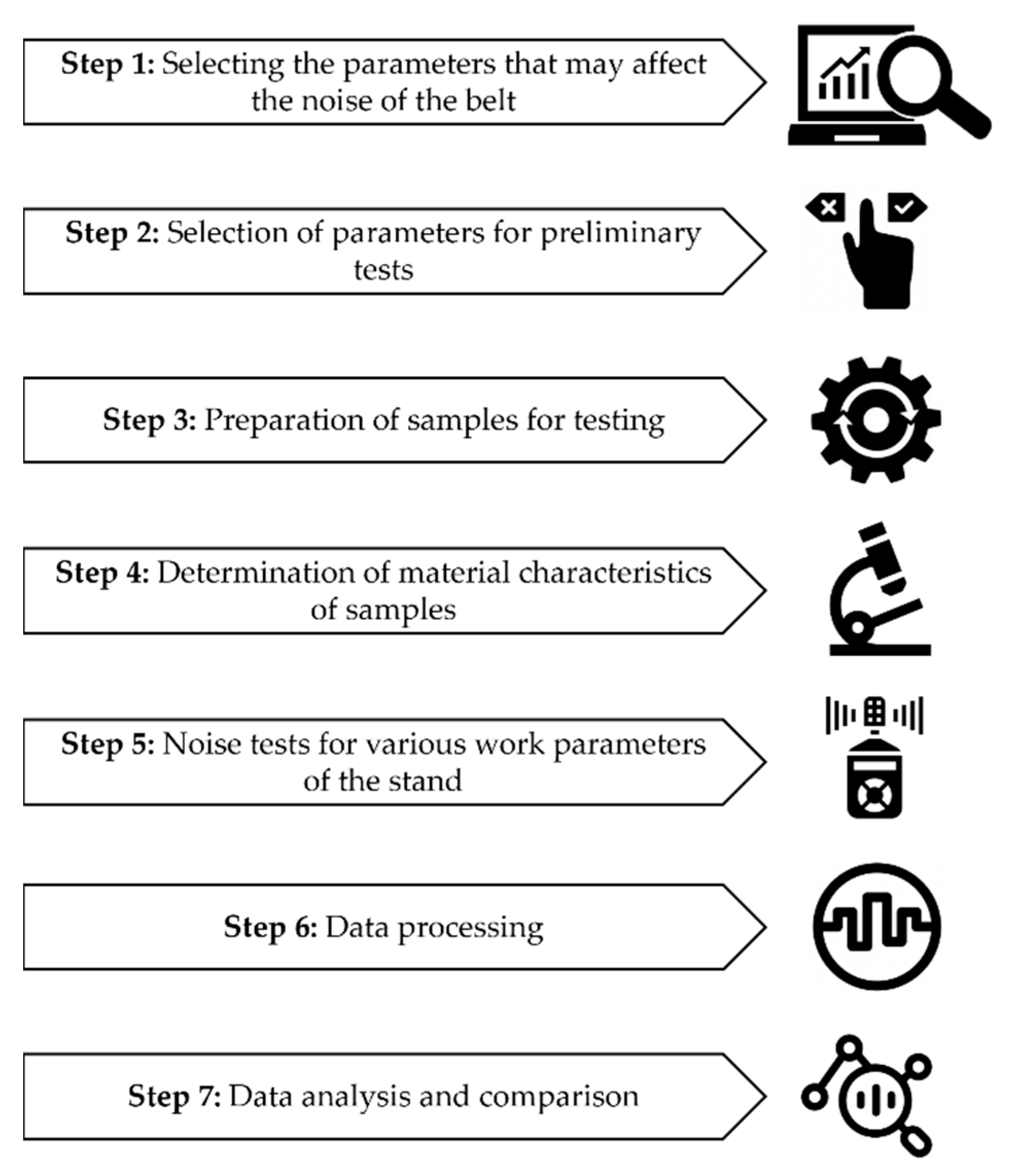
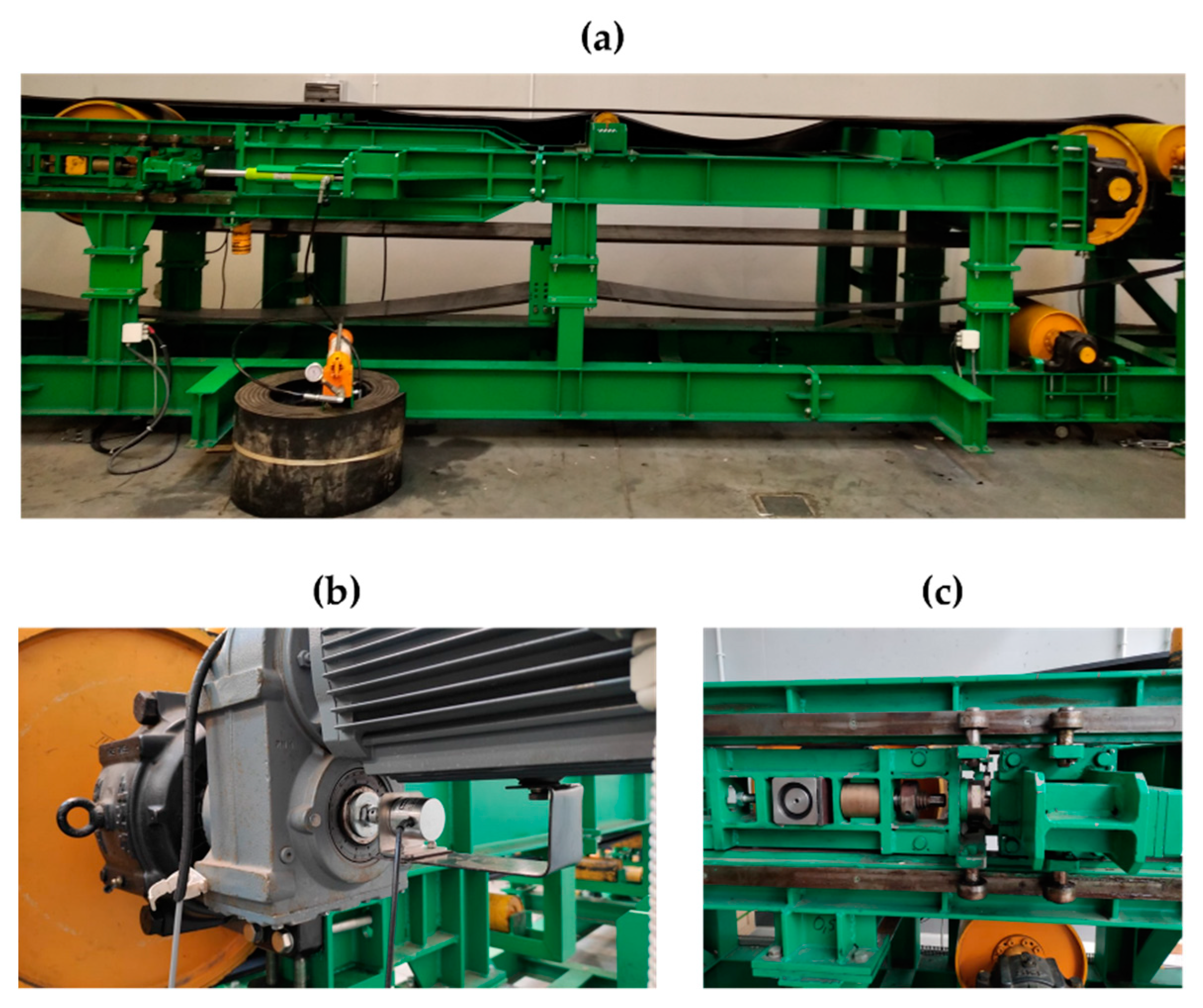
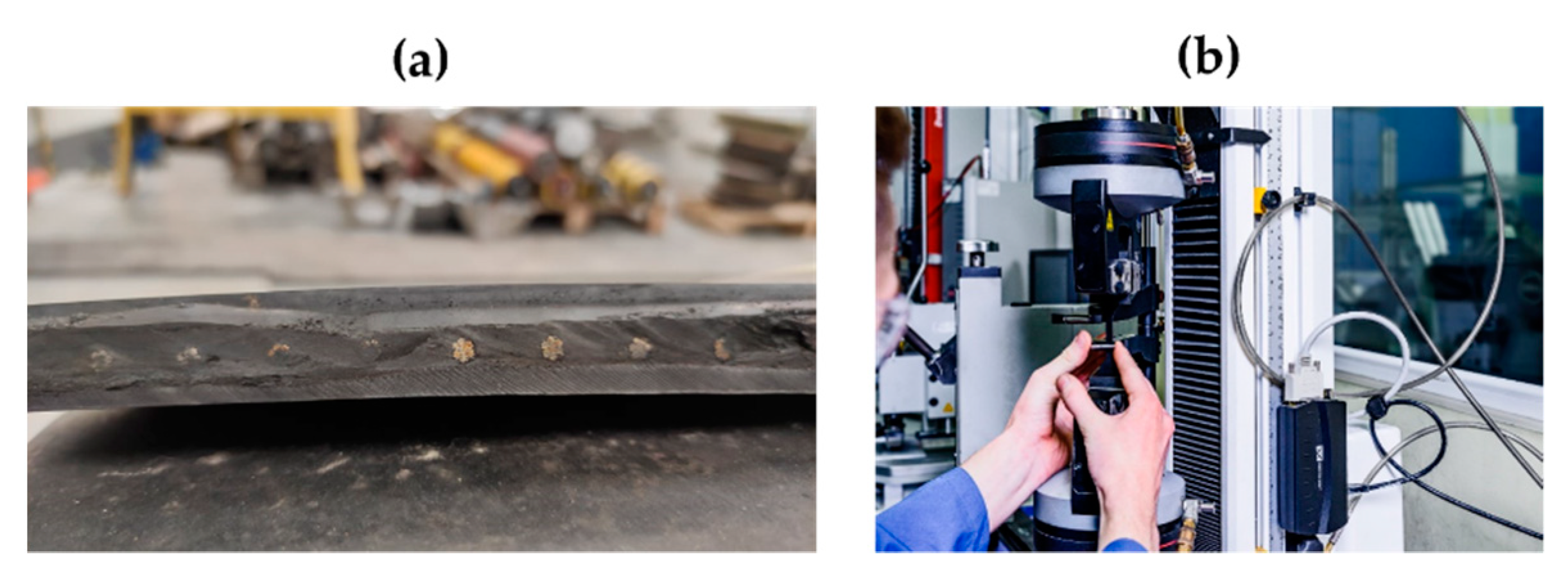

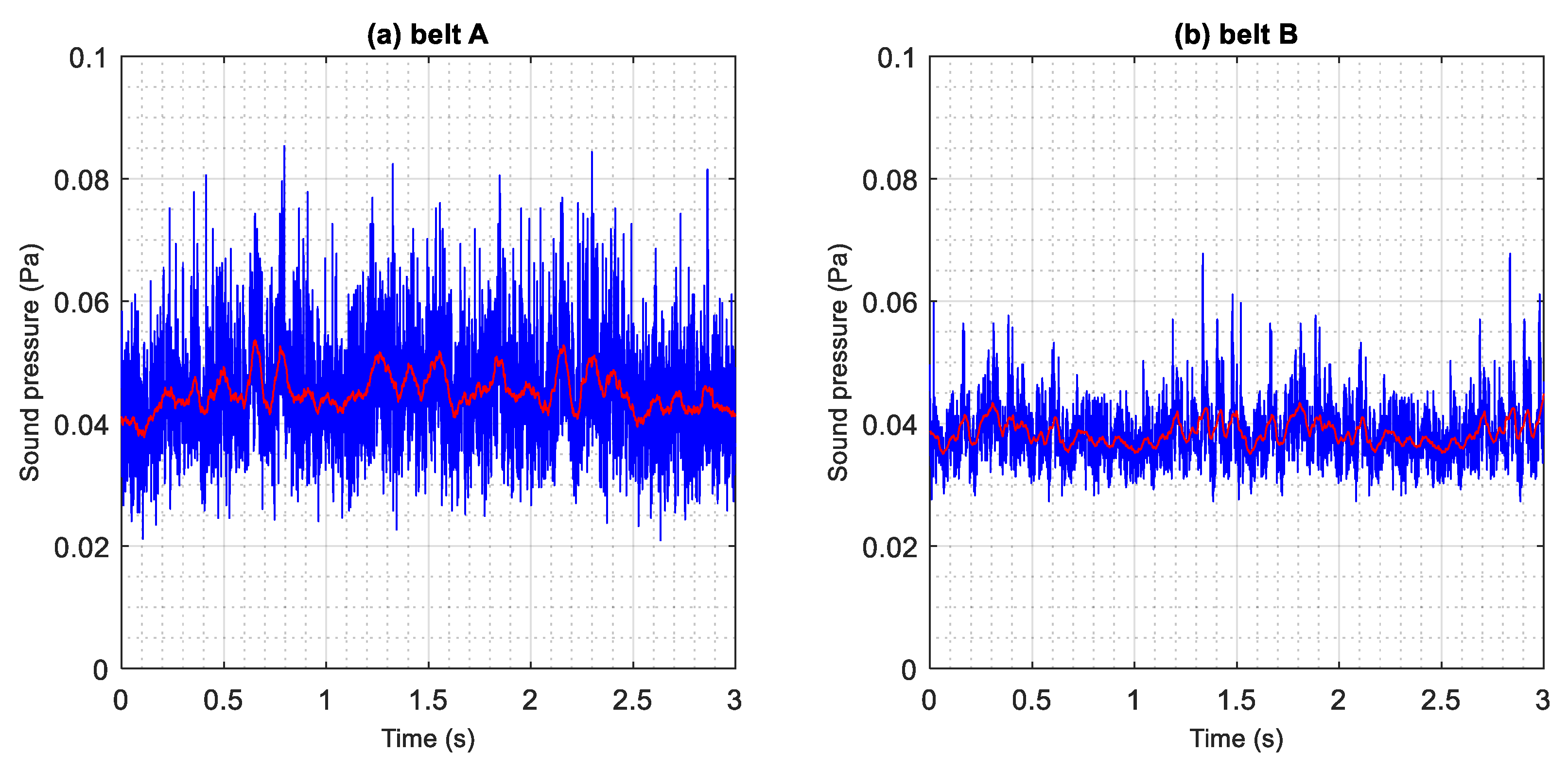
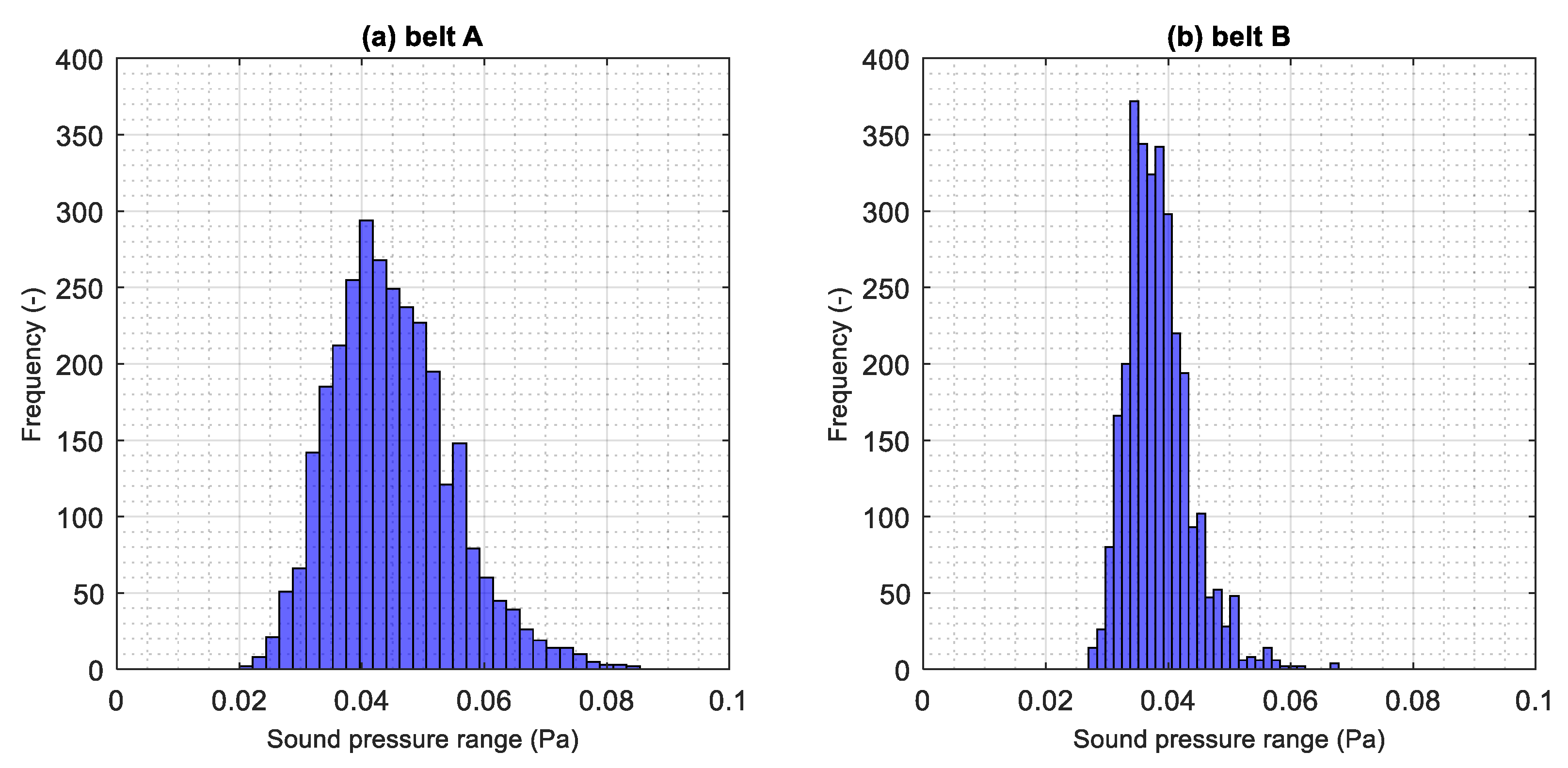
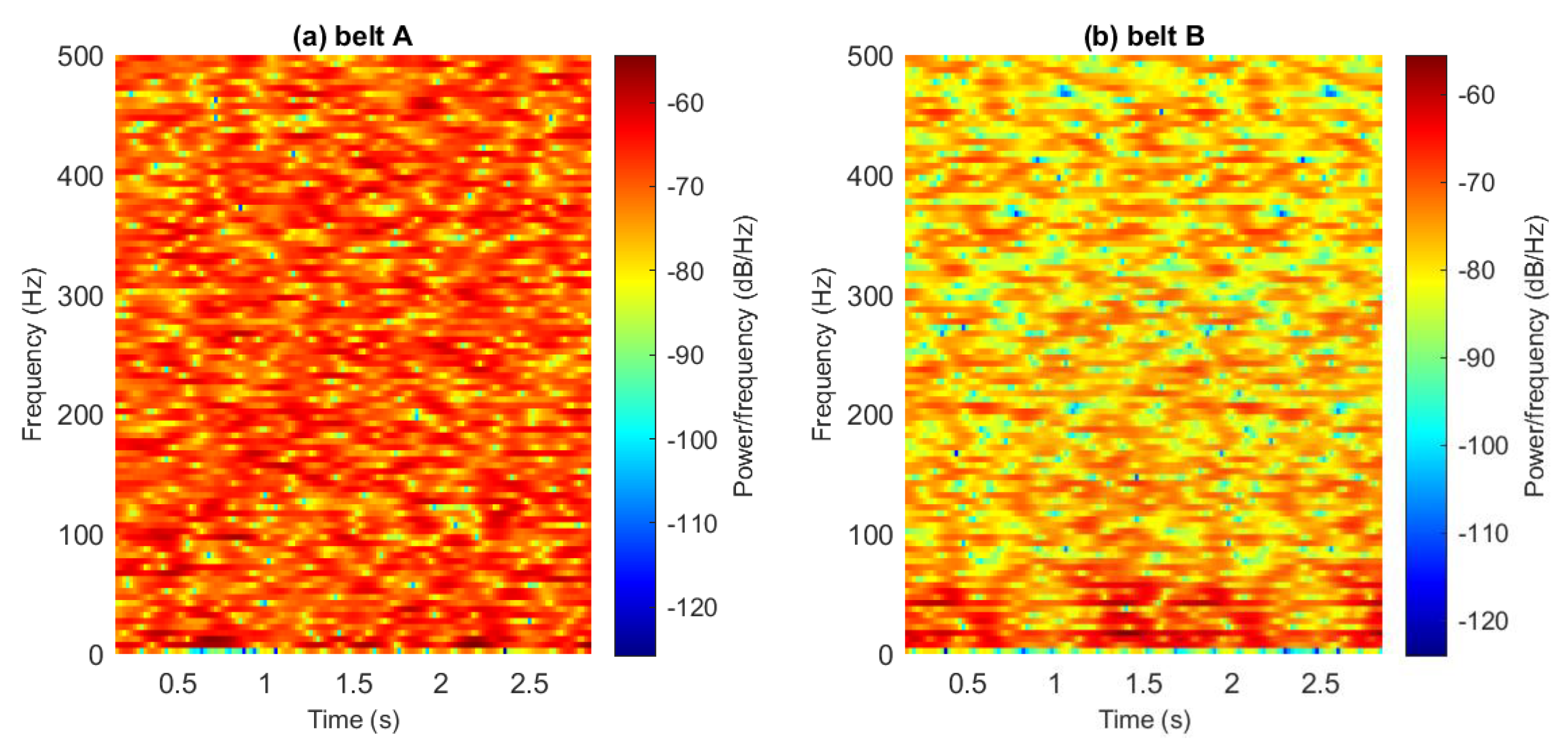
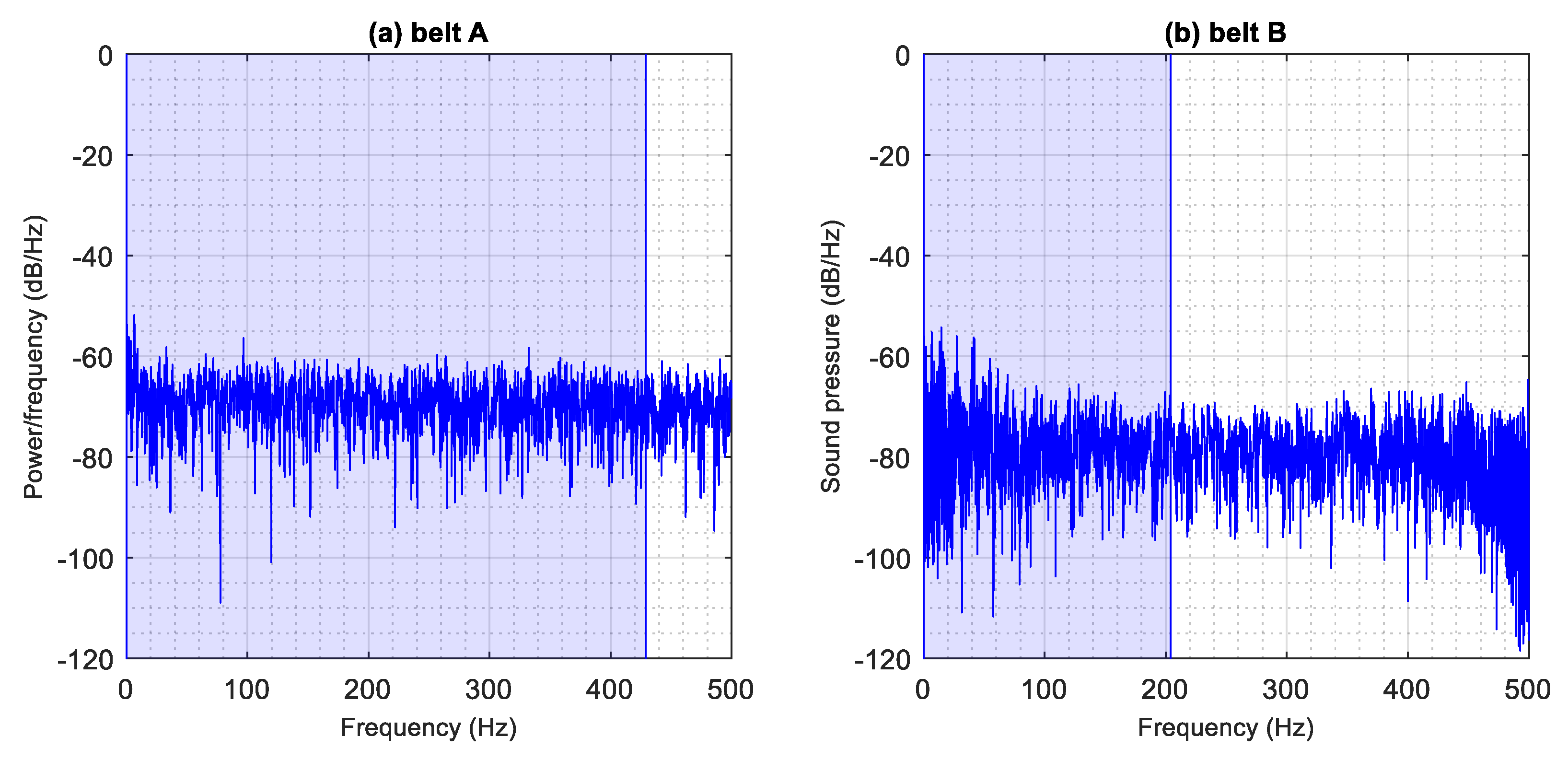
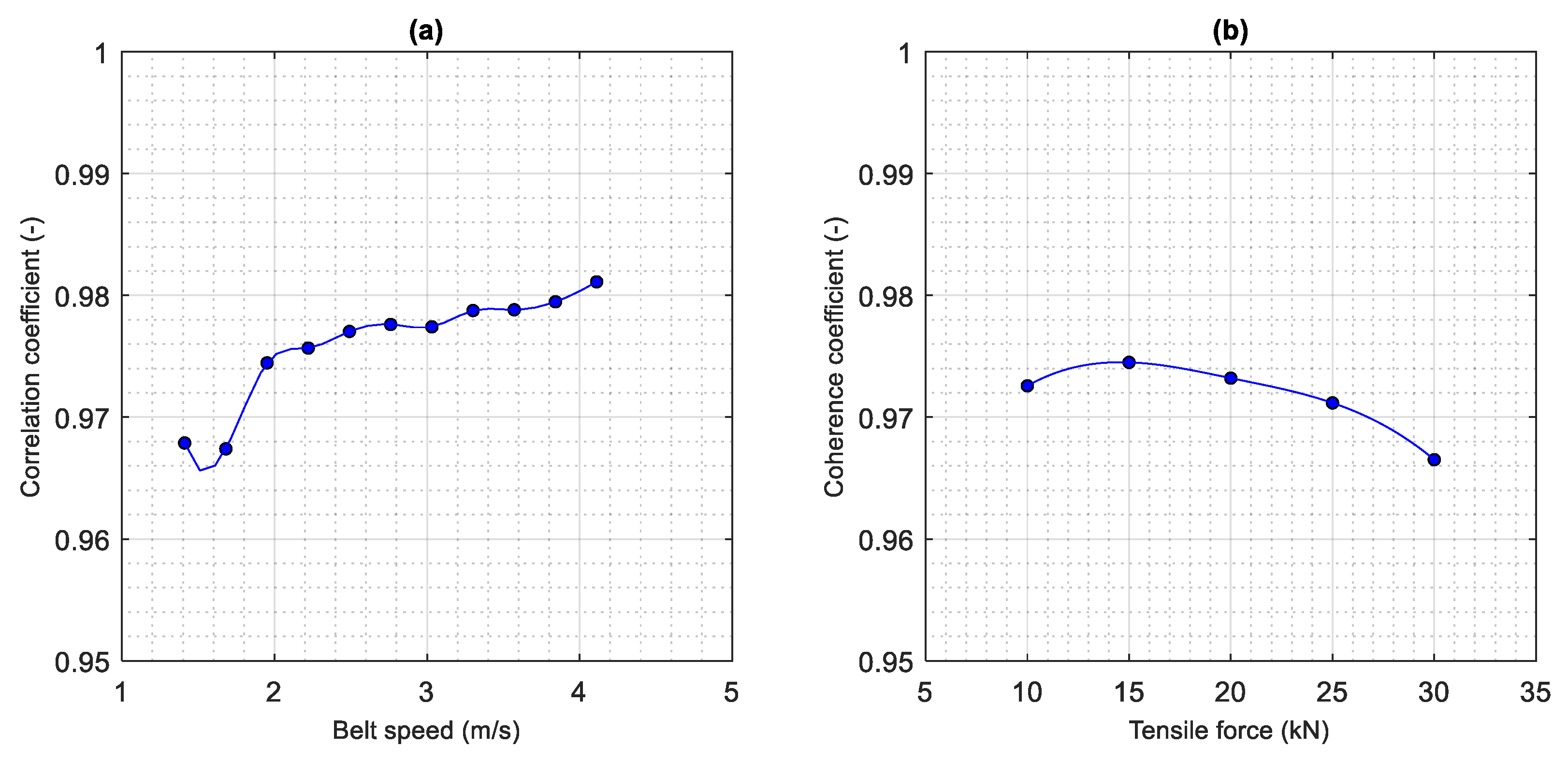
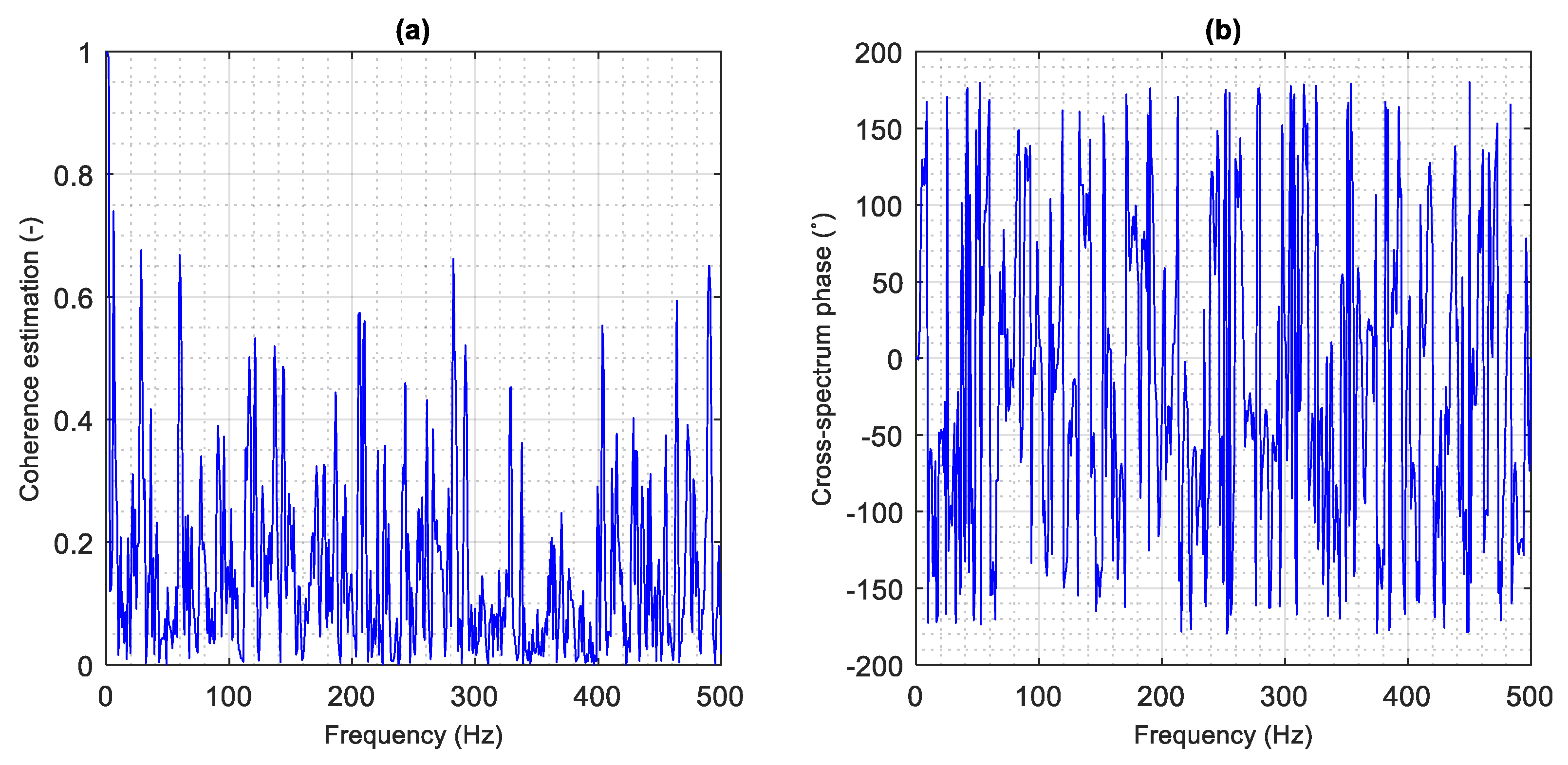

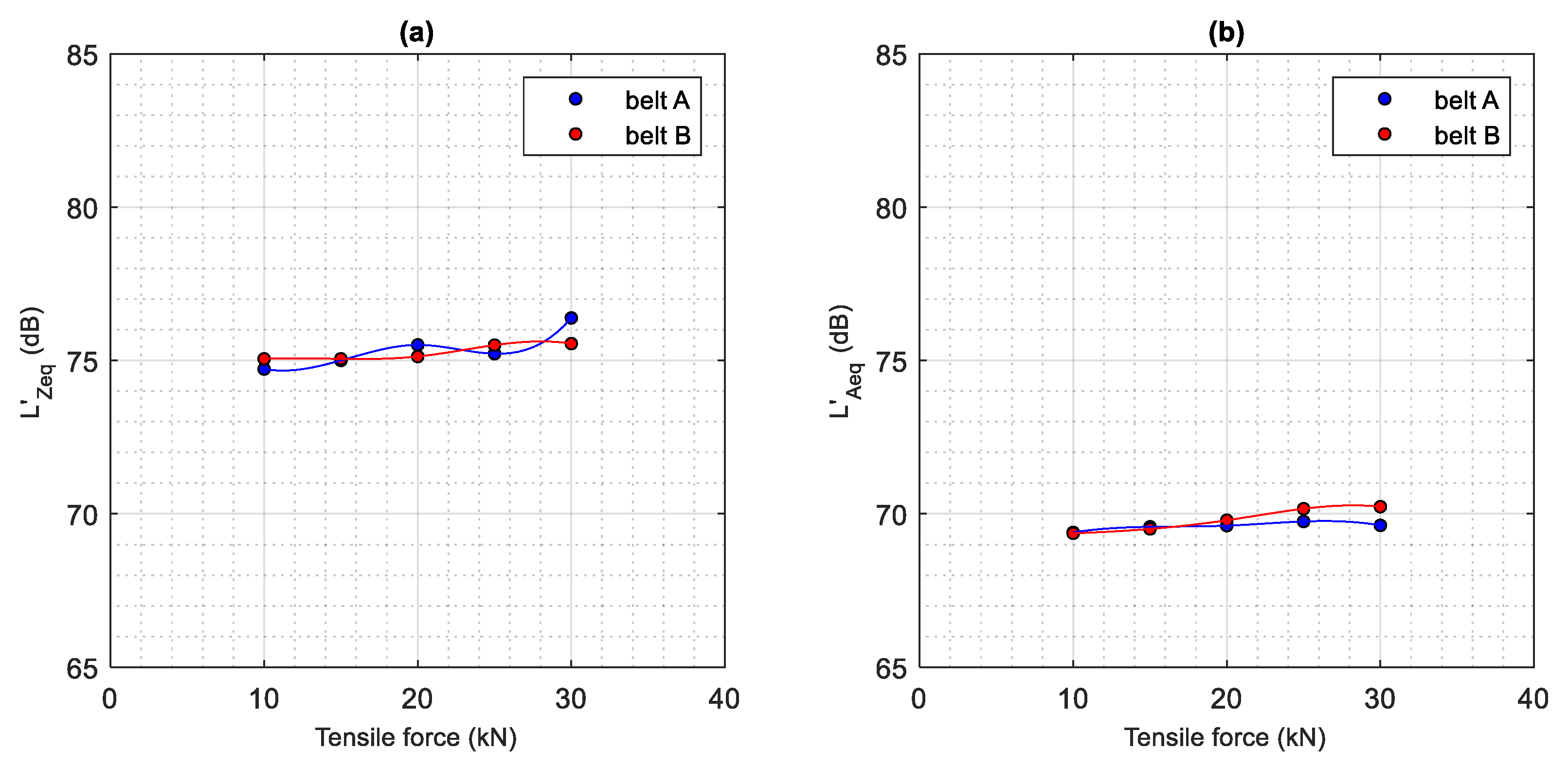
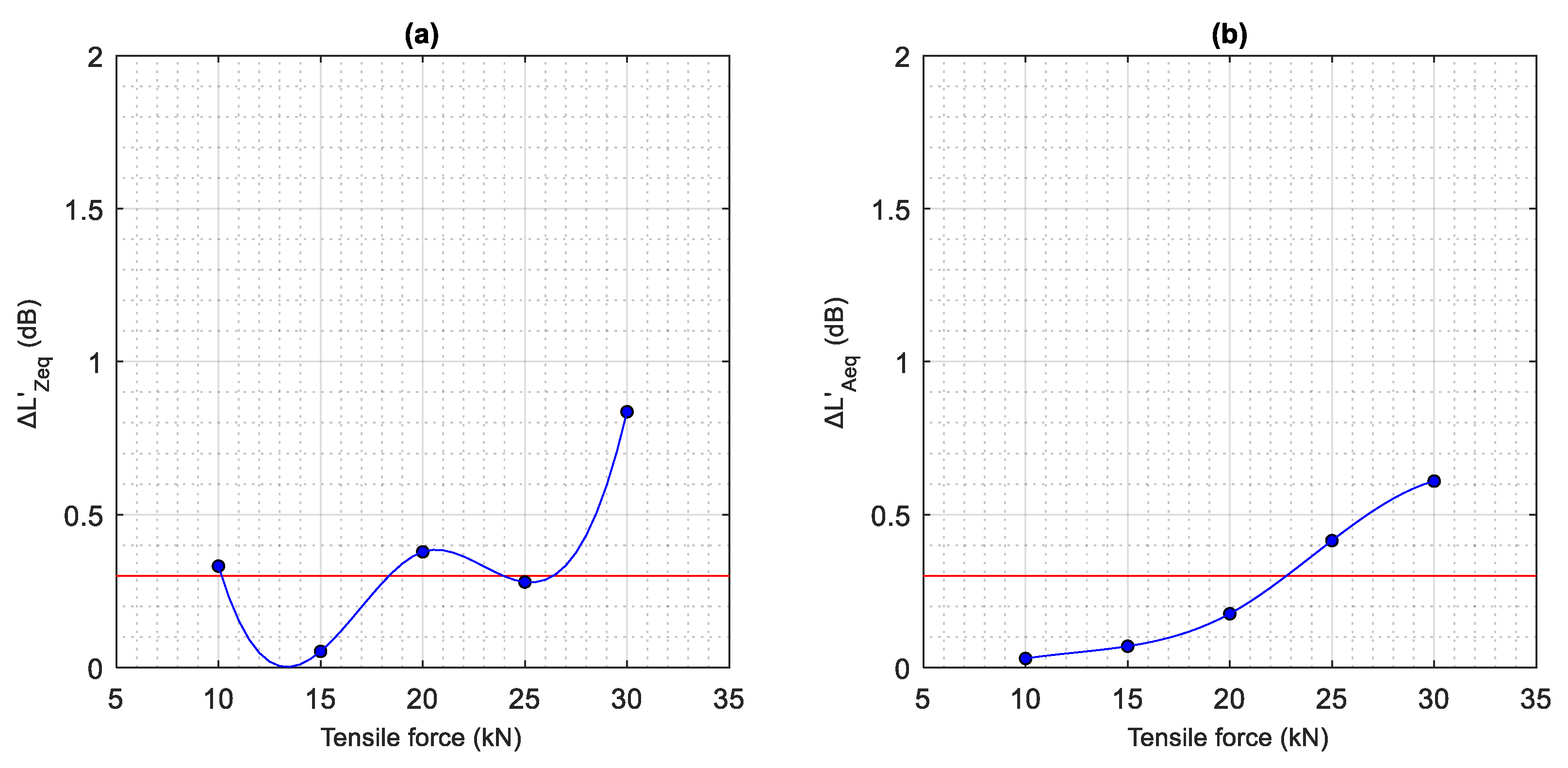
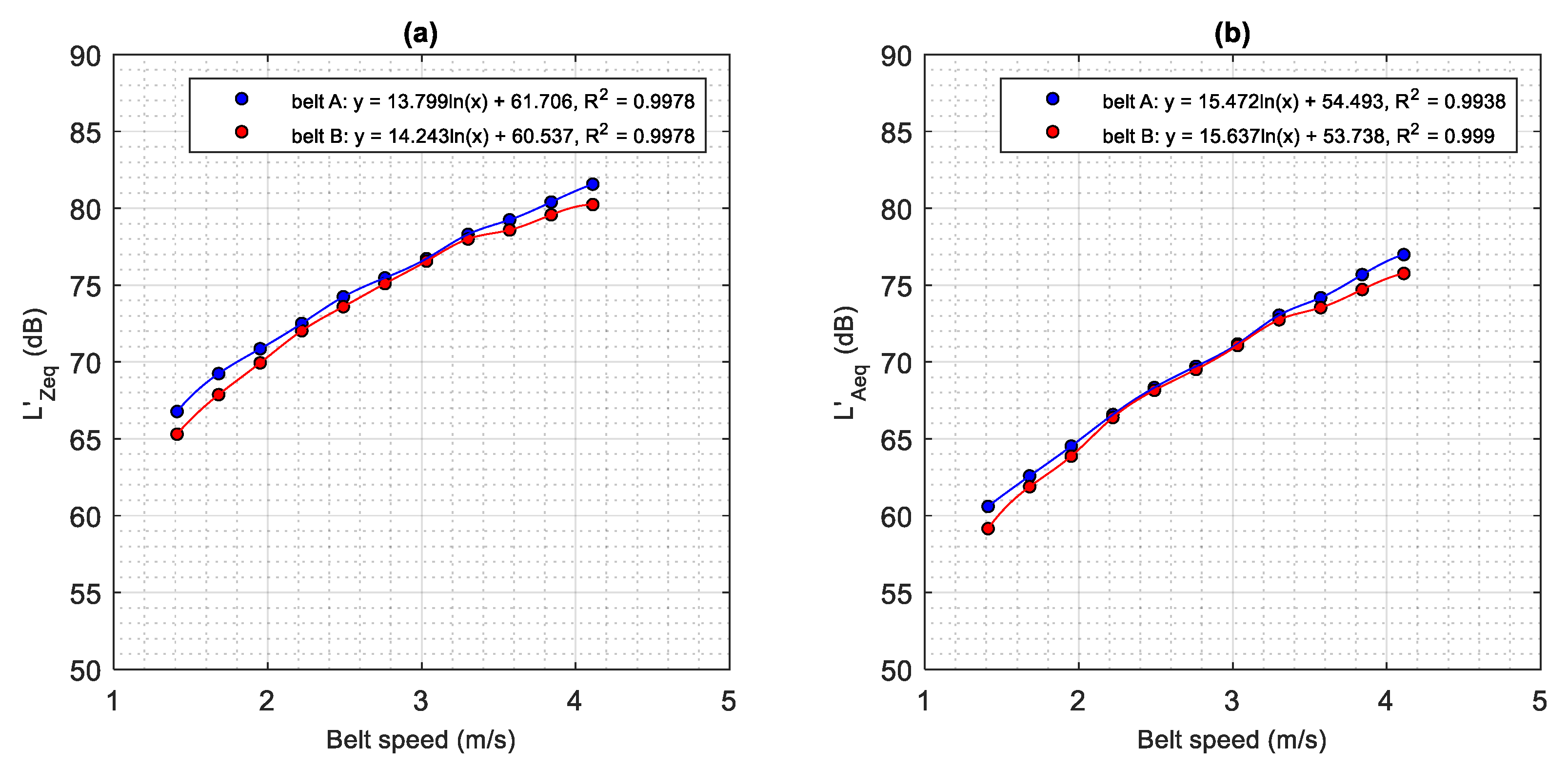

| Characteristic | Unit | Standard | Value | ||
|---|---|---|---|---|---|
| 1. Basic Information | |||||
| 1.1 | Type of belt | - | - | A—standard | B—new properties |
| 1.2 | Belt width | mm | ISO 15236-1 | 400 | 400 |
| 1.3 | Strenght of belt | N/mm | ISO 7622-2 | 800 | 800 |
| 1.4 | Top cover thickness | mm | ISO 7590 | 8.0 | 8.0 |
| 1.5 | Bottom cover thickness | mm | ISO 7591 | 5.0 | 5.0 |
| 1.6 | Total belt thickness | mm | ISO 7592 | 16.7 | 16.7 |
| 1.7 | Cord pitch | mm | Sempertrans | 15.0 | 15.0 |
| 1.8 | Steel cord diameter | mm | - | 3.7 | 3.7 |
| 2. Cover rubber | |||||
| 2.1 | Tensile strenght | MPa | ISO 37 | 25 | 21 |
| 2.2 | Elongation at break | % | ISO 38 | 550 | 520 |
| 2.3 | Abrasion resistance | mm3 | ISO 4649 | 60 | 60 |
| 2.4 | Hardness | Shore A | ISO 7619-1 | 62 | 58 |
| 3. Adhesion | |||||
| 3.1 | Top cover to core rubber | N/mm | ISO 8094 | 20 | 20 |
| 3.2 | Bottom cover to core rubber | N/mm | ISO 8095 | 18 | 18 |
| 4. Cord pull-out strength from ready belt | |||||
| 4.1 | Before ageing | N/mm | ISO 7623 | 90 | 90 |
| 4.2 | After reheatin (150 min. at 145 °C) | N/mm | ISO 7624 | 75 | 75 |
Publisher’s Note: MDPI stays neutral with regard to jurisdictional claims in published maps and institutional affiliations. |
© 2022 by the authors. Licensee MDPI, Basel, Switzerland. This article is an open access article distributed under the terms and conditions of the Creative Commons Attribution (CC BY) license (https://creativecommons.org/licenses/by/4.0/).
Share and Cite
Bortnowski, P.; Król, R.; Nowak-Szpak, A.; Ozdoba, M. A Preliminary Studies of the Impact of a Conveyor Belt on the Noise Emission. Sustainability 2022, 14, 2785. https://doi.org/10.3390/su14052785
Bortnowski P, Król R, Nowak-Szpak A, Ozdoba M. A Preliminary Studies of the Impact of a Conveyor Belt on the Noise Emission. Sustainability. 2022; 14(5):2785. https://doi.org/10.3390/su14052785
Chicago/Turabian StyleBortnowski, Piotr, Robert Król, Anna Nowak-Szpak, and Maksymilian Ozdoba. 2022. "A Preliminary Studies of the Impact of a Conveyor Belt on the Noise Emission" Sustainability 14, no. 5: 2785. https://doi.org/10.3390/su14052785
APA StyleBortnowski, P., Król, R., Nowak-Szpak, A., & Ozdoba, M. (2022). A Preliminary Studies of the Impact of a Conveyor Belt on the Noise Emission. Sustainability, 14(5), 2785. https://doi.org/10.3390/su14052785







